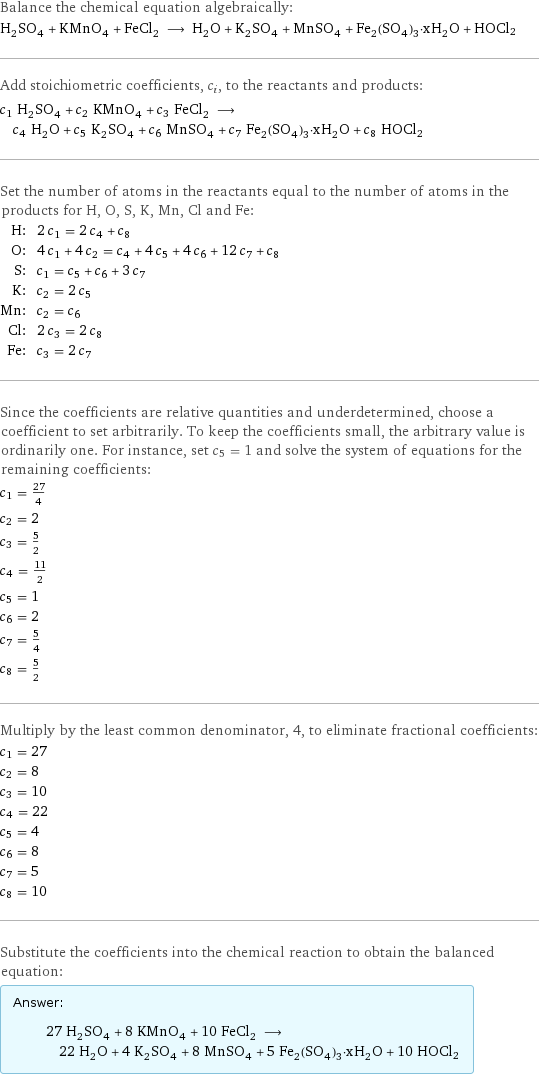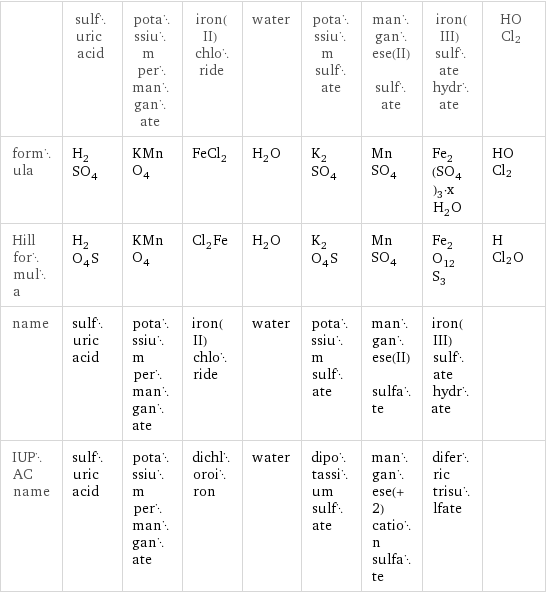Input interpretation

H_2SO_4 sulfuric acid + KMnO_4 potassium permanganate + FeCl_2 iron(II) chloride ⟶ H_2O water + K_2SO_4 potassium sulfate + MnSO_4 manganese(II) sulfate + Fe_2(SO_4)_3·xH_2O iron(III) sulfate hydrate + HOCl2
Balanced equation

Balance the chemical equation algebraically: H_2SO_4 + KMnO_4 + FeCl_2 ⟶ H_2O + K_2SO_4 + MnSO_4 + Fe_2(SO_4)_3·xH_2O + HOCl2 Add stoichiometric coefficients, c_i, to the reactants and products: c_1 H_2SO_4 + c_2 KMnO_4 + c_3 FeCl_2 ⟶ c_4 H_2O + c_5 K_2SO_4 + c_6 MnSO_4 + c_7 Fe_2(SO_4)_3·xH_2O + c_8 HOCl2 Set the number of atoms in the reactants equal to the number of atoms in the products for H, O, S, K, Mn, Cl and Fe: H: | 2 c_1 = 2 c_4 + c_8 O: | 4 c_1 + 4 c_2 = c_4 + 4 c_5 + 4 c_6 + 12 c_7 + c_8 S: | c_1 = c_5 + c_6 + 3 c_7 K: | c_2 = 2 c_5 Mn: | c_2 = c_6 Cl: | 2 c_3 = 2 c_8 Fe: | c_3 = 2 c_7 Since the coefficients are relative quantities and underdetermined, choose a coefficient to set arbitrarily. To keep the coefficients small, the arbitrary value is ordinarily one. For instance, set c_5 = 1 and solve the system of equations for the remaining coefficients: c_1 = 27/4 c_2 = 2 c_3 = 5/2 c_4 = 11/2 c_5 = 1 c_6 = 2 c_7 = 5/4 c_8 = 5/2 Multiply by the least common denominator, 4, to eliminate fractional coefficients: c_1 = 27 c_2 = 8 c_3 = 10 c_4 = 22 c_5 = 4 c_6 = 8 c_7 = 5 c_8 = 10 Substitute the coefficients into the chemical reaction to obtain the balanced equation: Answer: | | 27 H_2SO_4 + 8 KMnO_4 + 10 FeCl_2 ⟶ 22 H_2O + 4 K_2SO_4 + 8 MnSO_4 + 5 Fe_2(SO_4)_3·xH_2O + 10 HOCl2
Structures

+ + ⟶ + + + + HOCl2
Names

sulfuric acid + potassium permanganate + iron(II) chloride ⟶ water + potassium sulfate + manganese(II) sulfate + iron(III) sulfate hydrate + HOCl2
Equilibrium constant
![Construct the equilibrium constant, K, expression for: H_2SO_4 + KMnO_4 + FeCl_2 ⟶ H_2O + K_2SO_4 + MnSO_4 + Fe_2(SO_4)_3·xH_2O + HOCl2 Plan: • Balance the chemical equation. • Determine the stoichiometric numbers. • Assemble the activity expression for each chemical species. • Use the activity expressions to build the equilibrium constant expression. Write the balanced chemical equation: 27 H_2SO_4 + 8 KMnO_4 + 10 FeCl_2 ⟶ 22 H_2O + 4 K_2SO_4 + 8 MnSO_4 + 5 Fe_2(SO_4)_3·xH_2O + 10 HOCl2 Assign stoichiometric numbers, ν_i, using the stoichiometric coefficients, c_i, from the balanced chemical equation in the following manner: ν_i = -c_i for reactants and ν_i = c_i for products: chemical species | c_i | ν_i H_2SO_4 | 27 | -27 KMnO_4 | 8 | -8 FeCl_2 | 10 | -10 H_2O | 22 | 22 K_2SO_4 | 4 | 4 MnSO_4 | 8 | 8 Fe_2(SO_4)_3·xH_2O | 5 | 5 HOCl2 | 10 | 10 Assemble the activity expressions accounting for the state of matter and ν_i: chemical species | c_i | ν_i | activity expression H_2SO_4 | 27 | -27 | ([H2SO4])^(-27) KMnO_4 | 8 | -8 | ([KMnO4])^(-8) FeCl_2 | 10 | -10 | ([FeCl2])^(-10) H_2O | 22 | 22 | ([H2O])^22 K_2SO_4 | 4 | 4 | ([K2SO4])^4 MnSO_4 | 8 | 8 | ([MnSO4])^8 Fe_2(SO_4)_3·xH_2O | 5 | 5 | ([Fe2(SO4)3·xH2O])^5 HOCl2 | 10 | 10 | ([HOCl2])^10 The equilibrium constant symbol in the concentration basis is: K_c Mulitply the activity expressions to arrive at the K_c expression: Answer: | | K_c = ([H2SO4])^(-27) ([KMnO4])^(-8) ([FeCl2])^(-10) ([H2O])^22 ([K2SO4])^4 ([MnSO4])^8 ([Fe2(SO4)3·xH2O])^5 ([HOCl2])^10 = (([H2O])^22 ([K2SO4])^4 ([MnSO4])^8 ([Fe2(SO4)3·xH2O])^5 ([HOCl2])^10)/(([H2SO4])^27 ([KMnO4])^8 ([FeCl2])^10)](../image_source/bb524d93f1dd904adb5402f35aacc358.png)
Construct the equilibrium constant, K, expression for: H_2SO_4 + KMnO_4 + FeCl_2 ⟶ H_2O + K_2SO_4 + MnSO_4 + Fe_2(SO_4)_3·xH_2O + HOCl2 Plan: • Balance the chemical equation. • Determine the stoichiometric numbers. • Assemble the activity expression for each chemical species. • Use the activity expressions to build the equilibrium constant expression. Write the balanced chemical equation: 27 H_2SO_4 + 8 KMnO_4 + 10 FeCl_2 ⟶ 22 H_2O + 4 K_2SO_4 + 8 MnSO_4 + 5 Fe_2(SO_4)_3·xH_2O + 10 HOCl2 Assign stoichiometric numbers, ν_i, using the stoichiometric coefficients, c_i, from the balanced chemical equation in the following manner: ν_i = -c_i for reactants and ν_i = c_i for products: chemical species | c_i | ν_i H_2SO_4 | 27 | -27 KMnO_4 | 8 | -8 FeCl_2 | 10 | -10 H_2O | 22 | 22 K_2SO_4 | 4 | 4 MnSO_4 | 8 | 8 Fe_2(SO_4)_3·xH_2O | 5 | 5 HOCl2 | 10 | 10 Assemble the activity expressions accounting for the state of matter and ν_i: chemical species | c_i | ν_i | activity expression H_2SO_4 | 27 | -27 | ([H2SO4])^(-27) KMnO_4 | 8 | -8 | ([KMnO4])^(-8) FeCl_2 | 10 | -10 | ([FeCl2])^(-10) H_2O | 22 | 22 | ([H2O])^22 K_2SO_4 | 4 | 4 | ([K2SO4])^4 MnSO_4 | 8 | 8 | ([MnSO4])^8 Fe_2(SO_4)_3·xH_2O | 5 | 5 | ([Fe2(SO4)3·xH2O])^5 HOCl2 | 10 | 10 | ([HOCl2])^10 The equilibrium constant symbol in the concentration basis is: K_c Mulitply the activity expressions to arrive at the K_c expression: Answer: | | K_c = ([H2SO4])^(-27) ([KMnO4])^(-8) ([FeCl2])^(-10) ([H2O])^22 ([K2SO4])^4 ([MnSO4])^8 ([Fe2(SO4)3·xH2O])^5 ([HOCl2])^10 = (([H2O])^22 ([K2SO4])^4 ([MnSO4])^8 ([Fe2(SO4)3·xH2O])^5 ([HOCl2])^10)/(([H2SO4])^27 ([KMnO4])^8 ([FeCl2])^10)
Rate of reaction
![Construct the rate of reaction expression for: H_2SO_4 + KMnO_4 + FeCl_2 ⟶ H_2O + K_2SO_4 + MnSO_4 + Fe_2(SO_4)_3·xH_2O + HOCl2 Plan: • Balance the chemical equation. • Determine the stoichiometric numbers. • Assemble the rate term for each chemical species. • Write the rate of reaction expression. Write the balanced chemical equation: 27 H_2SO_4 + 8 KMnO_4 + 10 FeCl_2 ⟶ 22 H_2O + 4 K_2SO_4 + 8 MnSO_4 + 5 Fe_2(SO_4)_3·xH_2O + 10 HOCl2 Assign stoichiometric numbers, ν_i, using the stoichiometric coefficients, c_i, from the balanced chemical equation in the following manner: ν_i = -c_i for reactants and ν_i = c_i for products: chemical species | c_i | ν_i H_2SO_4 | 27 | -27 KMnO_4 | 8 | -8 FeCl_2 | 10 | -10 H_2O | 22 | 22 K_2SO_4 | 4 | 4 MnSO_4 | 8 | 8 Fe_2(SO_4)_3·xH_2O | 5 | 5 HOCl2 | 10 | 10 The rate term for each chemical species, B_i, is 1/ν_i(Δ[B_i])/(Δt) where [B_i] is the amount concentration and t is time: chemical species | c_i | ν_i | rate term H_2SO_4 | 27 | -27 | -1/27 (Δ[H2SO4])/(Δt) KMnO_4 | 8 | -8 | -1/8 (Δ[KMnO4])/(Δt) FeCl_2 | 10 | -10 | -1/10 (Δ[FeCl2])/(Δt) H_2O | 22 | 22 | 1/22 (Δ[H2O])/(Δt) K_2SO_4 | 4 | 4 | 1/4 (Δ[K2SO4])/(Δt) MnSO_4 | 8 | 8 | 1/8 (Δ[MnSO4])/(Δt) Fe_2(SO_4)_3·xH_2O | 5 | 5 | 1/5 (Δ[Fe2(SO4)3·xH2O])/(Δt) HOCl2 | 10 | 10 | 1/10 (Δ[HOCl2])/(Δt) (for infinitesimal rate of change, replace Δ with d) Set the rate terms equal to each other to arrive at the rate expression: Answer: | | rate = -1/27 (Δ[H2SO4])/(Δt) = -1/8 (Δ[KMnO4])/(Δt) = -1/10 (Δ[FeCl2])/(Δt) = 1/22 (Δ[H2O])/(Δt) = 1/4 (Δ[K2SO4])/(Δt) = 1/8 (Δ[MnSO4])/(Δt) = 1/5 (Δ[Fe2(SO4)3·xH2O])/(Δt) = 1/10 (Δ[HOCl2])/(Δt) (assuming constant volume and no accumulation of intermediates or side products)](../image_source/b32abeba570074dfbf77f5fb3a097886.png)
Construct the rate of reaction expression for: H_2SO_4 + KMnO_4 + FeCl_2 ⟶ H_2O + K_2SO_4 + MnSO_4 + Fe_2(SO_4)_3·xH_2O + HOCl2 Plan: • Balance the chemical equation. • Determine the stoichiometric numbers. • Assemble the rate term for each chemical species. • Write the rate of reaction expression. Write the balanced chemical equation: 27 H_2SO_4 + 8 KMnO_4 + 10 FeCl_2 ⟶ 22 H_2O + 4 K_2SO_4 + 8 MnSO_4 + 5 Fe_2(SO_4)_3·xH_2O + 10 HOCl2 Assign stoichiometric numbers, ν_i, using the stoichiometric coefficients, c_i, from the balanced chemical equation in the following manner: ν_i = -c_i for reactants and ν_i = c_i for products: chemical species | c_i | ν_i H_2SO_4 | 27 | -27 KMnO_4 | 8 | -8 FeCl_2 | 10 | -10 H_2O | 22 | 22 K_2SO_4 | 4 | 4 MnSO_4 | 8 | 8 Fe_2(SO_4)_3·xH_2O | 5 | 5 HOCl2 | 10 | 10 The rate term for each chemical species, B_i, is 1/ν_i(Δ[B_i])/(Δt) where [B_i] is the amount concentration and t is time: chemical species | c_i | ν_i | rate term H_2SO_4 | 27 | -27 | -1/27 (Δ[H2SO4])/(Δt) KMnO_4 | 8 | -8 | -1/8 (Δ[KMnO4])/(Δt) FeCl_2 | 10 | -10 | -1/10 (Δ[FeCl2])/(Δt) H_2O | 22 | 22 | 1/22 (Δ[H2O])/(Δt) K_2SO_4 | 4 | 4 | 1/4 (Δ[K2SO4])/(Δt) MnSO_4 | 8 | 8 | 1/8 (Δ[MnSO4])/(Δt) Fe_2(SO_4)_3·xH_2O | 5 | 5 | 1/5 (Δ[Fe2(SO4)3·xH2O])/(Δt) HOCl2 | 10 | 10 | 1/10 (Δ[HOCl2])/(Δt) (for infinitesimal rate of change, replace Δ with d) Set the rate terms equal to each other to arrive at the rate expression: Answer: | | rate = -1/27 (Δ[H2SO4])/(Δt) = -1/8 (Δ[KMnO4])/(Δt) = -1/10 (Δ[FeCl2])/(Δt) = 1/22 (Δ[H2O])/(Δt) = 1/4 (Δ[K2SO4])/(Δt) = 1/8 (Δ[MnSO4])/(Δt) = 1/5 (Δ[Fe2(SO4)3·xH2O])/(Δt) = 1/10 (Δ[HOCl2])/(Δt) (assuming constant volume and no accumulation of intermediates or side products)
Chemical names and formulas

| sulfuric acid | potassium permanganate | iron(II) chloride | water | potassium sulfate | manganese(II) sulfate | iron(III) sulfate hydrate | HOCl2 formula | H_2SO_4 | KMnO_4 | FeCl_2 | H_2O | K_2SO_4 | MnSO_4 | Fe_2(SO_4)_3·xH_2O | HOCl2 Hill formula | H_2O_4S | KMnO_4 | Cl_2Fe | H_2O | K_2O_4S | MnSO_4 | Fe_2O_12S_3 | HCl2O name | sulfuric acid | potassium permanganate | iron(II) chloride | water | potassium sulfate | manganese(II) sulfate | iron(III) sulfate hydrate | IUPAC name | sulfuric acid | potassium permanganate | dichloroiron | water | dipotassium sulfate | manganese(+2) cation sulfate | diferric trisulfate |
Substance properties

| sulfuric acid | potassium permanganate | iron(II) chloride | water | potassium sulfate | manganese(II) sulfate | iron(III) sulfate hydrate | HOCl2 molar mass | 98.07 g/mol | 158.03 g/mol | 126.7 g/mol | 18.015 g/mol | 174.25 g/mol | 150.99 g/mol | 399.9 g/mol | 87.91 g/mol phase | liquid (at STP) | solid (at STP) | solid (at STP) | liquid (at STP) | | solid (at STP) | | melting point | 10.371 °C | 240 °C | 677 °C | 0 °C | | 710 °C | | boiling point | 279.6 °C | | | 99.9839 °C | | | | density | 1.8305 g/cm^3 | 1 g/cm^3 | 3.16 g/cm^3 | 1 g/cm^3 | | 3.25 g/cm^3 | | solubility in water | very soluble | | | | soluble | soluble | slightly soluble | surface tension | 0.0735 N/m | | | 0.0728 N/m | | | | dynamic viscosity | 0.021 Pa s (at 25 °C) | | | 8.9×10^-4 Pa s (at 25 °C) | | | | odor | odorless | odorless | | odorless | | | |
Units
